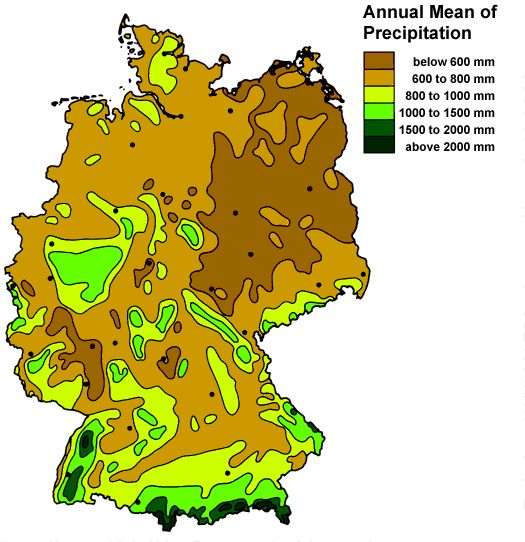Factors Affecting Precipitation
The intensity and distribution of precipitation determine the meteorological and climatic conditions of an area. They also directly affect groundwater recharge and the water supply available to plants. Precipitation also causes wash-outs from the atmosphere and, as "infiltration water" (cf.page), is the medium for transport of pollutants into the ground.
The average distribution of precipitation provides essential basic statements regarding precipitation phenomena in a given area. The distribution of precipitation in any given individual event, however, can deviate considerably from the average distribution. Strong rainfalls with unusual distribution of precipitation after the reactor accident at Chernobyl in May 1986 led to greater inputs of radioactive contamination in Europe (cf. Map 01.09, SenStadtUm 1992a).
Topography (surface configuration of the earth) is an important influence on the weather conditions of any given area. Mountain ranges, small groups of hill, and even low slopes influence precipitation quantities. This can be seen in the maps of average precipitation conditions of any given area. Other factors include forests, lakes, fields (cf. Flohn 1954). Residential areas of a certain size also influence quantities and distribution of precipitation.
One example is the increase of precipitation in the form of slope rains within a limited area. Slope rains are mainly due to the influence of bottom friction, the roughness parameter. Other influences in urban areas include increasing amounts of aerosols. The aerosols serve as nuclei for condensation, facilitating the formation of clouds and precipitation. Precipitation is also caused by the warmth of urban areas, in certain weather situations (convective precipitation).
An analysis of the effects of urban landscapes on precipitation quantities and distribution must distinguish between the influence of the urban landscape on any given precipitation process, and the role of the urban landscape as a catalyst for precipitation.
Effects of Precipitation
The effects of precipitation are also distinguished between those processes which purify the atmosphere and those processes resulting in pollutant contamination of the environment. Heavy precipitation does more than clean the air. High degrees of surface sealing and the extensive rain water and waste water disposal systems also result in the flushing of a range of pollutants in concentrated form into the storm sewer system and thus into bodies of water (cf. Map 02.09, SenStadtUm 1992b).
Berlin’s separate sewer system has about 3,000 km of storm sewers. The storm sewers collect dust, air pollutants, street surfacing and tire abrasion, oil spills, and other materials. This highly polluted precipitation water is diverted directly into smaller and larger bodies of water at approximately 730 sites. The combined sewer system collects domestic, commercial, and industrial waste waters as well as rainwater. Heavy precipitation can cause short-term overloading of the disposal system, resulting in the diversion of all combined, unpurified waters into the receiving bodies of water.
A quantification of the effects of urban structures on precipitation requires the long-term operation of an extensive monitoring network. In contrast to surrounding rural areas, the vertical structure of the city (heights of buildings and vegetation) must be considered, in addition to the topographical form of the land.
Regional Classification of Precipitation Conditions in Berlin
Precipitation conditions in Berlin are influenced at the regional scale by its location in a transitional area between continental and oceanic-influenced climate systems. Berlin is rather dry compared to other areas of Germany. The average annual quantity of precipitation is 568 mm per square meter. The "Brocken" mountain in southern Germany receives approximately 1,400 mm in an equal period of time. (cf. Fig. 1).

